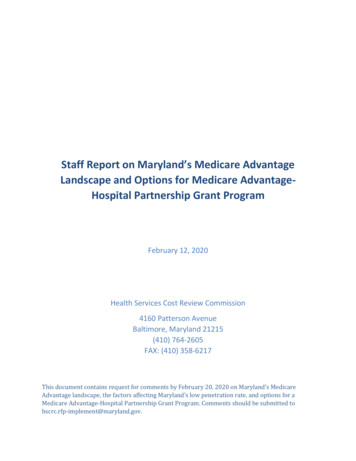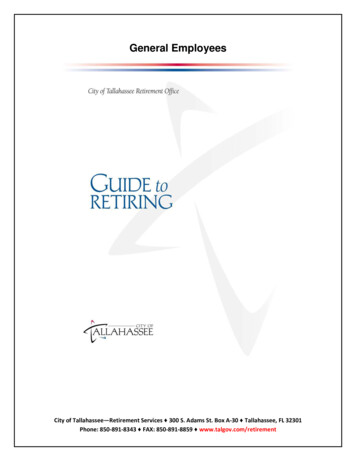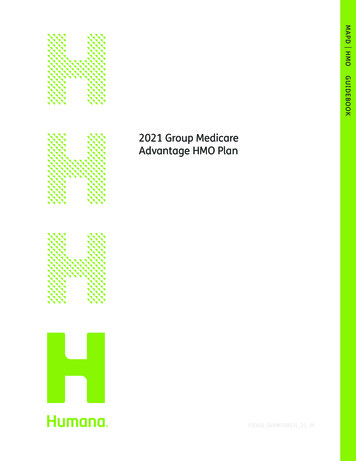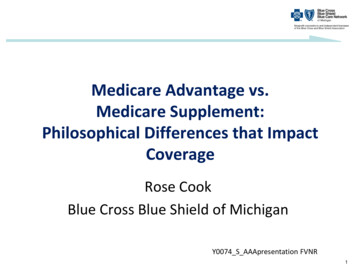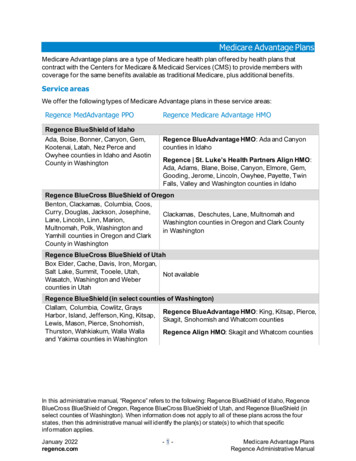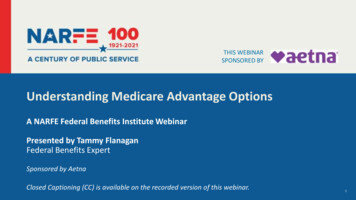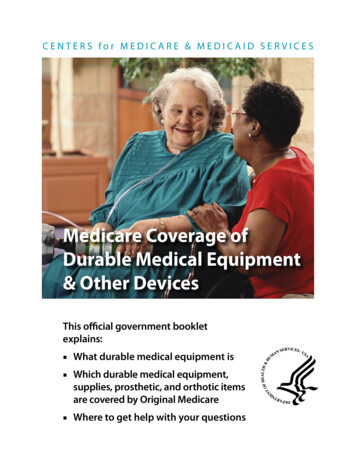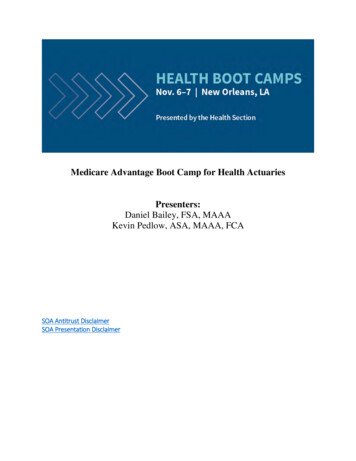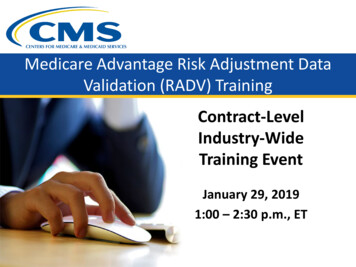
Transcription
Medicare Advantage Risk Adjustment DataValidation (RADV) TrainingContract-LevelIndustry-WideTraining EventJanuary 29, 20191:00 – 2:30 p.m., ET
Welcome and IntroductionsCenter for Program Integrity (CPI)Alec Alexander – Center DirectorGeorge Mills, Jr., – Deputy DirectorJonathan Smith –Program Manager (RADV Team)RADV Team MembersJoanne DavisLarry JohnsonBrenda M. JohnsonEsmail EssajeeEvan BoyarskyMelissa CooleyMelissa HeestersGulnur FreemanDelois NewkirkBeth SchalmMary B. WalkerMartha Wagley2
Agenda Highlights3
Contract-Level RADV TerminologyTerm DefinitionCY Calendar YearCON14 RADV CY 2014 Contract-Level RADVCMS Centers for Medicare & Medicaid ServicesCDAT Central Data Abstraction ToolHCC Hierarchical Condition CategoryINV Invalid4
Contract-Level RADV ional Classification of Diseases, NinthRevision, Clinical ModificationInternational Classification of Diseases, TenthRevision, Clinical ModificationMAOMedicare Advantage OrganizationMRRMedical Record ReviewPHIProtected Health InformationPIIPersonally, Identifiable InformationRARisk Adjustment5
Contract-Level RADV TerminologyTermDefinitionRADVRisk Adjustment Data ValidationRAPSRisk Adjustment Processing tion Category6
Contract-Level RADV Policy7
Contract-Level RADV Regulations Regulations at 42 C.F.R. 422.2, 422.310 (e) and422.311 govern the RADV process including:– Audit procedures and compliance dates– Appeals processes Reconsideration process for CON14 andcontract future years– Issuers eligible and ineligible for appeals8
Contract-Level RADV and Improper Payment Contract-Level RADV was implemented as the primarycorrective action plan to reduce the Part C error rate incompliance with the Improper Payments Elimination Act(IPIA) of 2002, as amended by the Improper PaymentsElimination and Recovery Act (IPERA) of 2010 andupdated by the Improper Payments Elimination andRecovery Improvement Act (IPERIA) of 2012. Contract-Level RADV audits support integrity of Part Cpayments by ensuring diagnoses submitted for riskadjustment are supported by medical recorddocumentation.9
Contract-Level RADV Policy The goal of Contract-Level RADV is to identifydiscrepancies in payments by comparing RAdiagnosis data submitted by a MAO forpayment against medical recorddocumentation provided by MAOs duringContract-Level RADV audits.10
Contract-Level RADV Policy All RAPS submitted RA diagnoses submitted by a MAOmust be:– Based on the clinical medical record documentation from aface-to-face encounter between patient andphysician/practitioner.– Coded in accordance with the ICD-9-CM Official Guidelinesfor Coding and Reporting and ICD-10-CM Official Guidelinesto diagnosis codes with dates of service after 10/01/15.– Assigned based on dates of service within the data collectionperiod.11
Contract-Level RADV Policy RA diagnoses submitted to CMS by MAOs must befrom an acceptable:– RA provider type (Physician, Hospital Inpatient, or HospitalOutpatient)– RA data source– RA physician specialty type12
Contract-Level RADV Policy MAOs selected for CON14 will have 20 weeks.1. Request medical records from providers.2. Prepare medical record files in PDF format.3. Submit the PDF files via a secure system calledthe Central Data Abstraction Tool (CDAT). Medical record file submission will beavailable in CDAT from the beginning of the20-week period.13
Part C Risk Adjustment Model The Part C CMS-HCC model is used to pay MAO plans for non-EndStage Renal Disease (ESRD) enrollees (with 12 months of Medicare PartB coverage during the data reporting period [i.e., full riskbeneficiaries]). There are three (3) possible scores produced by the model:– Community: Based on enrollees with less than 90 days in aninstitution.– Long-Term Institutional: Based on enrollees with more than 90days in an institution.– New Enrollee: Used for enrollees who are new to Medicare;operationalized as beneficiaries with less than 12 months ofMedicare Part B coverage.14
Risk Adjustment – How It Works CMS develops prospective RA models for Part C:– Diagnoses from Year One (1) are used to predict averagespending for Medicare fee-for-service populations in YearTwo (2).– Models contain approximately 3,000 diagnosis codes. Thisis the number of (ICD-9) diagnoses mappings to CMS-HCCs. Models include components for:– Demographics (Age, Sex, Medicaid Status, OriginalReason for Medicare Entitlement)– Disease groupings referred to as CMS-HCCs CMS-HCCs represent the disease component of theenrollee risk scores.15
Creating the Risk Adjustment Model Condition Categories (CCs):– ICD codes are clustered into related CCs.– Contain diagnoses that are clinically related and withsimilar Medicare predicted cost implications.– Relate to well-specified medical conditions: Hierarchy logic is imposed on certain CCs to account forhierarchical costs for the conditions (thus “HCCs”). CCs have relative risk factors assigned based on thepredicted costs. Risk factors represent marginal predicted costs, relativeto the average Medicare beneficiary.16
Reporting and Risk Score Calculation MAOs submit RAPS diagnosis data to CMS:– Enrollee diagnoses from dates of service within the datacollection period. Risk scores are calculated for:– Every Medicare beneficiary ICD-9-CM codes from Fee-for-Service (FFS) claims and datasubmitted from plans (risk score data can derive from plansubmitted data and FFS claims data).– A specific beneficiary Identify model (community, institutional, new enrollee, ESRD). Identify risk factors within model which apply (one [1] or more). Enrollee risk score Sum of all relative and frailty factors.17
Calculating the Risk Score Example: Mr. Jones is 73-years old and resides in Baltimore,Maryland. He was determined to be eligible for Medicaideffective September 2012 and has been a member of theSilver Health Plan for several years, having originallyqualified for Medicare due to disability. The MA contract alsooffers additional vision and dental benefits. His MAOsubmitted two (2) ICD-9 diagnostic codes with dates ofservice during 2013, the data collection year for paymentyear 2014:1. 185 – Prostate cancer (Malignant neoplasm prostate)2. 491.21 – Obstructive chronic bronchitis with (acute)exacerbationAll Data Provided on this Slide is Fictitious18
Calculating the Risk Score Sum the following relative factors:– Model variables for Mr. Jones: 73-year old male Non-institutionalized Medicaid Originally disabled– Disease Coefficients: V12 CMS-HCC model: HCC10, HCC108 V22 CMS-HCC model: HCC12, HCC111All Data Provided on this Slide is Fictitious19
Example of Payment Calculation Apply risk score(s) to payment using the basic Part C formula:[Base payment rate * enrollee risk score] additional paymentamount if MA contract offers certain supplemental benefits– Base payment rate 932 per member per month– Beneficiary risk score (unnormalized and unadjusted) V12 model 1.265 V22 model 1.196 Blended Risk score 0.25 (1.265) 0.75(1.196) 1.213– Additional payment amount of 32 for supplementalbenefits– CMS’ monthly payment to Silver Health Plan for Mr. Jones:( 932 * 1.213) 32 1,162.52All Data Provided on this Slide is Fictitious20
Mr. Jones and the Contract-LevelRADV Process Example: Mr. Jones is selected for the CY 2014 Contract-LevelRADV audit. Because Mr. Jones is selected, Silver Health Planmust submit medical records to validate HCC10 HCC12 andHCC108 HCC111 from dates of service within the data collectionperiod (January 1, 2013 through December 31, 2013). After Silver Health Plan has submitted medical records forHCC10 HCC12 and HCC108 HCC111, contract-level RADVmedical record coders review the records. During medical recordreview, coders validate HCC10 HCC12 but do not validateHCC108 HCC111.All Data Provided on this Slide is Fictitious21
Calculating Mr. Jones’ Post ContractLevel RADV Risk Score Because HCC108 HCC111 were not validated during the RADV auditMr. Jones’ risk score is recalculated using only HCC10 HCC12 Sum the following relative factors:– The model variables for Mr. Jones are still the same: 73-year old male Non-institutionalized Medicaid Originally disabled– The Disease Coefficients for Mr. Jones have changed: V12 CMS-HCC model: HCC10 V22 CMS-HCC model: HCC12All Data Provided on this Slide is Fictitious22
Silver Health Plan’s Post Contract-LevelRADV Payment Apply the post RADV risk score to payment using the basic Part C formulato calculate Silver Health Plan’s post RADV payment:[Base payment rate * post RADV enrollee risk score] additionalpayment amount if MA contract offers certain supplemental benefits– Base payment rate 932 per member per month– Post RADV Beneficiary risk score (unnormalized and unadjusted) V12 model 0.925 V22 model 0.850 Blended Risk score 0.25 (0.925) 0.75(0.850) 0.869– Additional payment amount of 32 for supplemental benefits– CMS’ post RADV monthly payment to Silver Health Plan for Mr. Jones:( 932 * 0.869) 32 841.91All Data Provided on this Slide is Fictitious23
Payment Adjustment for Mr. Jones CMS initially paid 1,162.52 monthly to Silver HealthPlan According to the contract-level RADV audit results forMr. Jones, CMS should have paid Silver Health Plan 841.91 monthly In this case, CMS initially overpaid Silver Health Plan Based on the circumstances of this example, CMS willproceed with a payment adjustment for Silver HealthPlanAll Data Provided on this Slide is Fictitious24
Helpful Resources on Risk Adjustment(RA) and Risk Scores MAO Advance Notices of Methodological Changes,announcements issued for MA rates, and specialreports are available tml25
Contract-Level RADV Time FrameActivityPeriodMAOs Selected for AuditTBDMAOs Access to the CDATResource Library3 weeks after selection notificationMAOs Selected Plans Training1 day before submission windowopensSubmission WindowMAOs will have 20 weeks to submitrecordsNOTE: an HPMS memo is forthcoming with the actual dates.26
Sampling Methodology27
Sampling CMS selects enrollees from eligible MA contracts according tocertain criteria, including:– Examples of contract eligibility criteria Coordinated Care Plans (CCPs), including local HMOs, Local PPOs, RegionalPPOs, PSOs, SNPs Demonstrations MSA contracts PFFS Contracts Employer/Union Only Direct Contract PFFS– Examples of enrollee eligibility criteria At least one (1) CMS-HCC assigned resulting in a positive risk-adjustmentpayment amount for the payment year in question Continuous enrollment in the contract for the entire data collection period andthe first month of the payment year No end-stage renal disease (ESRD) and hospice status– For selected enrollees, all audited CMS-HCCs that contributed to therisk-adjusted payments for the payment year in question will bereviewed.28
Proposed Sampling Methodology Based on statistically valid sampling and proposed* extrapolationmethodologies within MA contracts and/or sub-cohorts– Determine MA contract– Select statistically valid random sample of enrollees– Review enrollee medical records– Calculate payment adjustments*Although audits will be designed so that the individuals selected will form astatistically significant sample that would support an extrapolated recovery,we will not seek to recover on an extrapolated basis until an extrapolationmethodology is finalized. At the very least, these audits will supportenrollee level recoveries.29
CDAT Modernization30
CDAT ModernizationObjectives of Modernization: Improved user experience to include: Screen consolidation – fewer clicks resulting in better userproductivity Modern look and feel – better presentation, easier to navigate More information readily available – provide users withinformation aide in timely processing of tasks User self management – ability to self manage accounts,currently a Help Desk function Improved system performance – will increase user productivity31
CDAT Modernization – Plan Portal Default to Plan Portal screen upon loginOne URL for CDAT; multiple sample selection based on authorizationPlan Library, My Account and Log Out accessible on all screens of the applicationTerms and Conditions acceptance upon login for ALL authorized HMOIDsAll Data Provided on this Slide is Fictitious
CDAT Modernization - Plan Portal:Terms and ConditionsAll Data Provided on this Slide is Fictitious33
CDAT Modernization - List of Enrollees No scroll horizontal bar in gridOne click on the enrollee name to open the record“Back to” links return user to previous page All Data Provided on this Slide is FictitiousSearch by Enrollee ID functionalityProgress Filters34
CDAT Modernization -EnrolleeSubmission ManagementAll Data Provided on this Slide is Fictitious35
CDAT Modernization - EnrolleeSubmission Management Continued Back to link returns the user to the previous screen Search by Coversheet ID Filters by CMS-HCC, Type and Issue CMS-HCCs are presented on the screen rather than in ascrolling grid Add Coversheet provides 2 format options; Guided and Single–Guided format for a novice user–Single format for an experienced user36
CDAT Modernization – ReviewCoversheetAll Data Provided on this Slide is Fictitious37
Automated Intake OptionObjectives: Automates portions of the CDAT medical record (MR) intake reviewprocess Conducts around-the-clock review of MR submissions inaccordance with current RADV parameters, submission rules, andcoding guidanceBenefits: Improves the overall speed of review Provides faster feedback to MAOs on the validity of the submissionConsiderations: MR submissions identified with potential issues or that cannot beprocessed with a high degree of confidence during automatedintake review will be escalated to manual review for confirmation The MAO will be given the choice to “opt in” to automated review38
Automated Intake OptionContinuedAutomation Opt In ScreenAll Data Provided on this Slide is Fictitious39
CDAT Modernization – My AccountAll Data Provided on this Slide is Fictitious40
CDAT Modernization – My AccountContinued Users are able to edit the following informationon the My Account screen: Email address, contact phone and mobile phoneReset passwordUpdate Security question and answerUpdate multi-factor authentication method41
Medical Record Reviewer (MRR) Guidance42
Medical Record Reviewer Guidance Posted on the Medicare RADV Program Website:– Data-Validation-Program/Resources.html. Purpose:– To guide MAO pre-submission medical recordreview/selection decisions.– To provide consistent application of documentation validitydecisions to the CMS review contractors.– To reiterate policies, submission instructions, and officialcoding guidance that apply to RADV.43
Medical Record Reviewer GuidanceContent RADV policy with excerpts from contract-level RADVsubmission instructions Attestation validity Submission/intake validity and compliance Signature and Credentials Dates Provider type/record (source) type Reporting of chronic and other additional diagnosesin ICD-9-CM (applicable for CON14) Acceptable RA Physician Specialty list44
Medical Record Review The specific documentation, ICD-9-CM guidelines,provider type and dates of service identified andselected for review may result in coding decisionsthat have a direct impact on the medical recordreview results and payment error estimate. CDAT CMS coversheet is first compared to themedical record submitted.45
Medical Record Review (continued) Prior to coding, CMS medical record review contractorsreview each medical record submitted for validity. At a minimum, medical records must meet the followingrequirements to avoid a discrepant finding:– Acceptable RA provider type (Physician, HospitalInpatient, Hospital Outpatient)– Physician specialty– Dates of service within the data collection period– Contain valid signatures and credentials If missing, use CMS-Generated Attestation– Correct beneficiary46
Medical Record Review (continued) Medical records arereviewed to determineif they are valid forRADV purposes.Reasons a medicalrecord could be invalidinclude:Code DescriptionINV1 Wrong enrollee/No nameINV2 Missing signatureINV3 Name variationINV4 Date missingINV5 Invalid sourceINV7 Unacceptable credential/specialtyINV14 Date outside data collection periodINV15 Provider type mismatchINV17 Unacceptable medical recorddocumentationINV20 Other47
Medical Record Review (continued) RADV coders will review and code the valid medical record submitted toconfirm the documentation is:– Based on the clinical face-to-face encounter between patient andphysician/practitioner.– Coded in accordance with the ICD-9-CM Official Guidelines for Coding andReporting and AHA Coding Clinic for ICD 9 (or ICD-10-CM Official Guidelinesfor Coding and Reporting and AHA Coding Clinic for ICD 10). Coders will abstract all reportable codes within acceptable date(s) of service inthe data collection year. CDAT tool HCC mapping result is compared to RAPS enrollee profile todetermine discrepancies. All coding discrepancies are confirmed using independent coders. Coders consult the RADV Medical Record Reviewer Guidance when faced withpotential inconsistencies in medical record documentation.48
Continuous Plan Feedback Report49
Continuous Plan Feedback Report (CPFR) Increases transparency and reduces plan burden byproviding interim results on a rolling basis Allows plans to stay current on submission progress Near real time reporting of preliminary MRR Outcomes Key metrics provide information around a plan’s auditedenrollees, audited CMS-HCCs, top invalid MR reasons,and associated payments Detailed view of each Medical Record submission Ex. Submission date, validity status, reasons forinvalid, initial findings50
Accessing the Continuous Plan FeedbackReport (CPFR) Plan Points of Contact may view reports for theirauthorized plans Authorized users can access reports using Chrome or IE Log in to the SAS Visual Analytics portal using MultiFactor Authentication (MFA)51
Continuous Plan Feedback Report TemplateAll Data Provided on this Slide is Fictitious52
Next Steps & Resources53
Additional Resources RA Website:– dvtgSpecRateStats/Risk-Adjustors.html Medicare RADV Program Website:– Data-Validation-Program/Overview.html54
Contact InformationThe CMS RADV Team is available to provide assistancethroughout this process. Email is the most effective means of communication. Support hours are 9:00 a.m. to 6:00 p.m. ET. All questions related to RADV policies and procedures shouldbe directed to CMS at radv@cms.hhs.gov.– Use the RADV Enrollee ID or Coversheet ID whencommunicating about a specific enrollee or submission.– Responses will be provided during normal business hours.55
Final Reminders Share this slide deck with others in your MAOworking on Contract-Level RADV (e.g., thoseselecting medical records for submission). Do not send PHI/PII to the RADV@cms.hhs.govmailbox.56
Conclusion If you have any further questions about CMSContract-Level RADV, please contact CMS atradv@cms.hhs.gov with subject “RADV.” Additional communication resources will be providedat a later date if your MA Contract is selected for afuture audit. Thank you for your participation!57
58
payment amount if MA contract offers certain supplemental benefits - Base payment rate 932 per member per month - Post RADV: Beneficiary risk score (unnormalized and unadjusted) V12 model 0.925 V22 model 0.850 Blended Risk score 0.25 (0.925) 0.75(0.850) 0.869 - Additional payment amount of 32 for supplemental .

